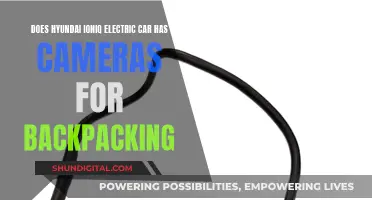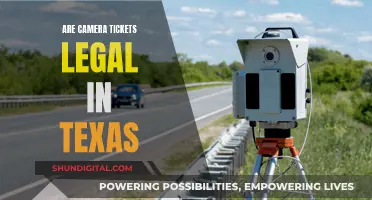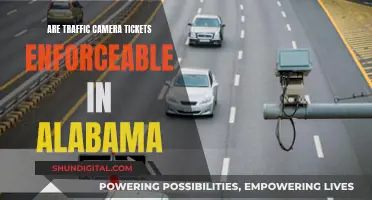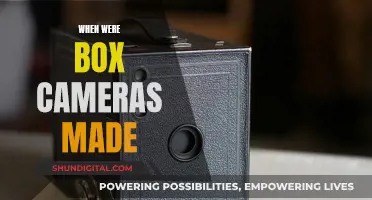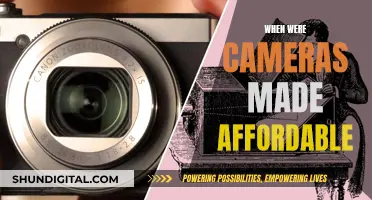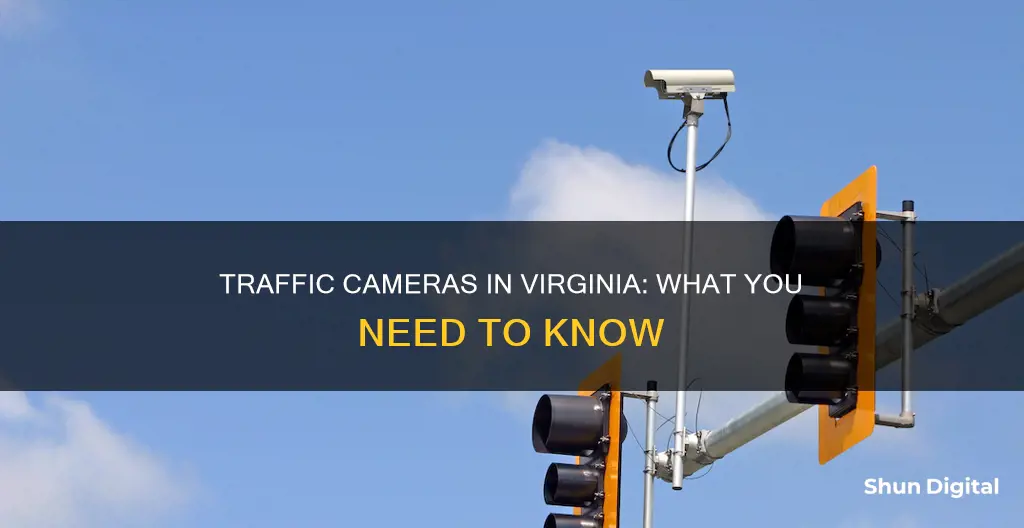
Virginia has implemented a series of traffic monitoring systems to enforce traffic light signals and certain traffic control devices. These systems include the use of traffic cameras installed at intersections with high rates of traffic incidents due to red-light violations, as well as in school zones, road construction zones, and highway work zones. The use of these cameras is regulated by the Code of Virginia, which specifies the procedures for issuing citations and penalties for violations captured by the cameras. The registered owner of the vehicle receives a notice of violation and can challenge the citation in traffic court if they were not the driver at the time. The effectiveness of these cameras in preventing crashes has been debated, with some studies showing mixed results.
| Characteristics | Values |
|---|---|
| Purpose | To monitor unsafe driving and encourage drivers to follow traffic laws |
| Types of cameras | Red light cameras, speed cameras |
| Locations | School zones, road construction zones, intersections with high rates of traffic incidents due to red light violations |
| Notification | Signs are placed near intersections to inform drivers of camera locations |
| Evidence review | Evidence is reviewed by multiple people, including city police officers, before citations are issued |
| Citations | Issued to the registered owner of the vehicle; can be challenged in traffic court |
| Fines | Can be prepaid on the website or by calling a toll-free number |
What You'll Learn

Virginia's red light cameras
Virginia Beach and Fairfax City have implemented red light camera systems to monitor and enforce traffic light signals. These systems are designed to improve road safety and reduce the number of red light violations, which are commonly observed by residents.
In Virginia Beach, the PHOTOSafe program uses photo enforcement camera systems to deter motorists from running red lights. When a vehicle runs a red light, the system captures photographs or video evidence of the violation. The registered owner of the vehicle is then issued a civil penalty, which can be reviewed and paid online. The PHOTOSafe program has been successful due to public knowledge of the system and the assurance that violations will be recorded and penalised.
Fairfax City's "Respect Red" program aims to reduce traffic incidents caused by red light violations. Cameras are installed at intersections with high rates of red light-related incidents. These include Fairfax Boulevard (Route 29/50), Jermantown Road, Fair Woods Parkway, and Main Street (Route 236). Multiple cameras monitor traffic at these intersections, and citations are issued after evidence is reviewed by police officers and other authorised personnel. The registered owner of the vehicle receives a notice of violation, along with a secure PIN to access the citation and related information online.
The use of red light cameras in Virginia is authorised under the Code of Virginia, which outlines the regulations for establishing traffic signal enforcement programs. The governing body of a county, city, or town may implement such programs to impose monetary liability on the operator of a motor vehicle for failing to comply with traffic light signals. The code defines "traffic light signal violation monitoring systems" and outlines the requirements for evidence collection, liability determination, and privacy protection.
The presence of red light cameras in Virginia Beach and Fairfax City demonstrates a commitment to road safety and the enforcement of traffic laws. By utilising technology and establishing clear consequences for violations, these programs aim to reduce the number of red light-related incidents and create safer roads for motorists, pedestrians, and the community.
Fight Red-Light Camera Tickets: Know Your Rights
You may want to see also

Traffic monitoring in Fairfax
The City of Fairfax, Virginia, has implemented two programs to monitor traffic and improve road safety: Respect Red and Speed Enforcement. Respect Red involves installing cameras at city road intersections with high rates of traffic incidents due to red-light violations. Multiple cameras monitor traffic at these intersections, and signs inform drivers of the camera locations. The cameras are placed at the following intersections:
- Fairfax Boulevard (Route 29/50) at Fairfax Circle (eastbound & westbound)
- Fairfax Boulevard (Route 29/50) at Jermantown Road (eastbound & westbound)
- Fairfax Boulevard (Route 29/50) at Fair Woods Parkway (eastbound)
- Main Street (Route 29) at Jermantown Road (southbound)
- Main Street (Route 236) at Pickett Road (westbound)
- Main Street (Route 236) at Woodland Drive (eastbound)
- North Street (Route 236) at University Drive (eastbound & westbound)
The Speed Enforcement program involves installing cameras in school zones and road construction zones to monitor vehicle speeds. The cameras are currently operational in the following school zones:
- Blenheim Boulevard
- Route 236/Main Street
- Jermantown Road
The zones encompass the city's four schools and two Fairfax County schools: Woodson High School and Frost Middle School. Portable cameras are also available to enforce reduced speed limits in highway work zones, protecting city work crews and contractors. The Speed Enforcement program began on August 22, 2022, coinciding with the start of the 2022-2023 school year.
The Traffic Signs and Signals Department in Fairfax is responsible for maintaining all traffic control devices, including traffic signals, signs, and pavement markings, to ensure the safe and orderly movement of traffic. The department adheres to national standards set forth in the Manual on Uniform Traffic Control Devices, published by the Federal Highway Administration.
In addition to the programs in Fairfax City, the County of Fairfax has launched a Speed Camera Pilot Program to improve road safety and reduce accidents and injuries. Photo speed monitoring devices have been activated in nine school zones, aiming to slow down drivers and protect pedestrians, especially in congested areas. The program includes an escalating fine structure for speeding violations, with a maximum fine of $100. The locations of the speed cameras in the pilot program include:
- Chesterbrook Elementary School: Kirby Road
- Irving Middle School: Old Keene Mill Road
- Key Middle School: Franconia Road
- London Towne Elementary School: Stone Road
- Sleepy Hollow Elementary School: Sleepy Hollow Road
- South County Middle School: Silverbrook Road
- Terraset Elementary School: Soapstone Drive
- West Springfield High School: Rolling Road
- Oakton High School: Blake Lane
Computer Cameras: Are Microphones Always Listening?
You may want to see also

Speed cameras in school zones
The City of Fairfax, Virginia, has implemented two programs to encourage drivers to follow traffic laws: Respect Red and Speed Enforcement. As part of the Speed Enforcement program, cameras have been installed in school zones and road construction zones. The cameras are placed in school zones on Blenheim Boulevard, Route 236/Main Street, and Jermantown Road, near the city's four schools and two Fairfax County schools (Woodson High School and Frost Middle School).
Market Basket's Parking Lot: Are Shoppers Being Watched?
You may want to see also

Traffic cameras and privacy
Traffic cameras are an increasingly common feature of modern life, with many cities across the United States installing them to monitor unsafe driving and encourage adherence to traffic laws. These cameras are often placed at intersections with high rates of traffic incidents and in school zones and road construction zones. While some people view these cameras as an invasion of privacy and a threat to individual liberties, others argue that they promote security and liberty by deterring traffic violations and reducing the need for police stops, which can be dangerous, especially for Black Americans.
Privacy Concerns
One of the primary concerns surrounding traffic cameras is the potential invasion of privacy. While the cameras themselves are placed in public spaces, capturing footage that is visible to anyone present, the data collected by these cameras can be used for purposes beyond tracking reckless drivers. This "mission creep" is a significant worry for civil liberties organizations like the ACLU, which has urged a halt to the use of red-light cameras until privacy and fairness issues are addressed. They argue that government and private-industry surveillance techniques created for one purpose are rarely restricted to that purpose, and the expansion of data collection opens the door to more privacy abuses. For example, cameras installed at the Texas-Oklahoma border have captured the license plate numbers of thousands of law-abiding citizens, who were then subjected to inquiries about their border crossings.
Due Process Concerns
In addition to privacy concerns, there are also due process issues raised by the use of traffic cameras. The tickets generated by these systems are typically sent to the owner of the vehicle, who may not have been the person committing the violation. This shifts the burden of proof to the owner, who must then prove that they were not driving at the time, a violation of the principle that an accused person is innocent until proven guilty. This dynamic was a key factor in the Missouri Supreme Court's decision to strike down St. Louis's red-light camera program in 2015.
Racial Bias Concerns
Another critical issue with traffic cameras is their potential to perpetuate racial bias in policing. While automated traffic enforcement (ATE) is often touted as a racially neutral alternative to traditional traffic stops, the deployment of speed cameras can disproportionately impact low-income communities and communities of color. A report by the D.C. Policy Center found that drivers in predominantly Black-segregated neighborhoods received twice as many traffic tickets per capita as the city's average, despite a similar number of crashes per capita compared to white neighborhoods. This disparity highlights how ATE can exacerbate existing racial biases in policing and further marginalize already vulnerable communities.
Financial Concerns
The financial implications of traffic cameras are also a cause for concern. The use of ATE can create perverse incentives for local governments and private companies to extract wealth from the public, particularly from low-income drivers and communities of color who are most impacted by traffic fines and fees. Fines and fees from traffic violations have become a significant source of revenue for many municipalities, leading to a focus on expanding ATE and strict enforcement rather than implementing traffic safety best practices. Additionally, the privatization of traffic enforcement through contracts with third-party vendors can prioritize profits over public safety and further erode trust in government.
In conclusion, while traffic cameras can have benefits in terms of deterring traffic violations and reducing police stops, there are significant privacy, due process, racial bias, and financial concerns that must be addressed to ensure their ethical and equitable use.
Tethering Your Camera to Your Computer: Lightworks Guide
You may want to see also

Challenging a traffic camera citation
Traffic camera citations are an increasingly common feature of the American road. While they are designed to improve road safety, they are not without controversy, and many drivers feel that they are simply a way of generating revenue.
If you have received a traffic camera citation, you may feel that it is an unfair imposition, and that you should challenge it. Here is a step-by-step guide to doing so.
Step 1: Examine Your Ticket
First, check the date, time, and location of the ticket. Camera tickets are sent to the owner of the car, not the driver, so make sure you were actually behind the wheel when the ticket was issued. If someone else borrowed your car, you cannot be prosecuted. However, in some states, such as New York, the registered owner is held liable, so be sure to check the relevant red light law. If you were driving, try to remember the details of the journey, and write down anything you recall. For example, you may have been making a legal turn when the camera took the photo.
Step 2: Plead Not Guilty
You must plead not guilty if you want to dispute the ticket. You can do this by mail, online, or in person at an arraignment. Check your citation for the deadline, which is typically 30 days.
Step 3: Request a Formal Hearing
When you plead not guilty, demand a full formal hearing or trial. This may require you to attend other hearings, such as a pre-trial or mediation, but do not accept anything less than a full dismissal of your ticket.
Step 4: Request Documents
Call the local police department to request copies of the photos if they were not included with your citation. You should also ask for full maintenance records for the camera and any associated equipment, such as a traffic light or speed monitor. If the equipment was not tested recently, the photo may be unreliable as evidence.
Step 5: Research Applicable Law
Look for cases in your city or county about traffic cameras, and see if any appellate court decisions have ruled on their legality. Also, research other possible defences, such as the requirement for warning signs, or a necessity defence for speeding.
Step 6: Appear at Your Hearing
Arrive at court with copies of any documents you intend to use as evidence. Treat the judge and staff with respect, and listen quietly while the prosecutor presents their case, making notes of any points you want to raise.
Step 7: Make Your Defence
There are several ways to defend yourself against a traffic camera citation. You can challenge the admissibility of the photograph as hearsay, or assert your right to confront witnesses. If no one from the company that maintains the camera shows up to testify, you can dispute the authenticity of the photograph. You can also argue that the prosecution cannot prove you were driving, or that the traffic light or speed monitor was functioning properly. Finally, if all else fails, you can raise any other possible defences you have found in your research.
Important Things to Note
- Some jurisdictions treat red-light camera tickets like parking violations, holding the registered owner liable.
- Warning signs may be required for traffic cameras, and if they are obscured or missing, you may have a defence.
- Some states recognise a necessity defence for speeding, for example, if you were driving to the hospital.
- If you live in Portland, Oregon, you may be eligible to take a traffic safety class and have your citation dismissed.
Focusing Your Huawei P10 Camera: Tips and Tricks
You may want to see also
Frequently asked questions
Yes, VA has traffic cameras.
Traffic cameras are installed at city road intersections with high rates of traffic incidents due to red-light violations. They are also installed in school zones, road construction zones, and highway work zones.
The cameras are used to monitor unsafe driving and encourage drivers to follow traffic laws. They are also used to record violations of traffic laws, such as speeding or running red lights.
If you are caught by a traffic camera, you may receive a citation or ticket. The registered owner of the vehicle will typically receive a notice of violation and a secure PIN to access the citation online. You may be able to challenge the citation in traffic court, especially if you were not the driver at the time of the violation.


